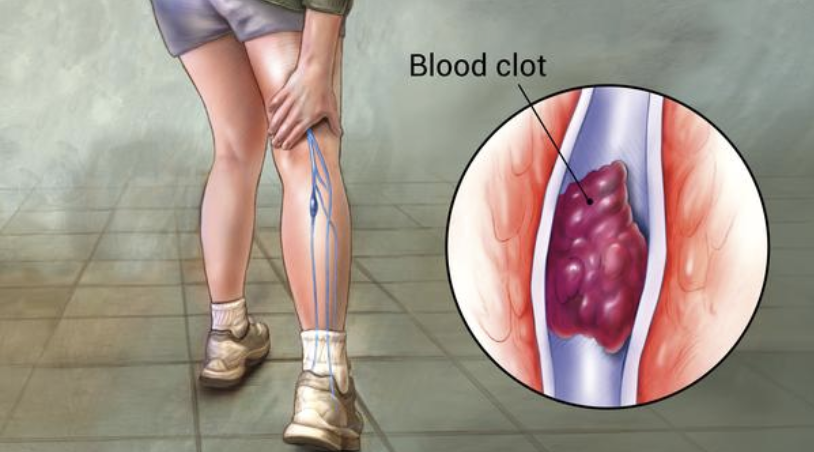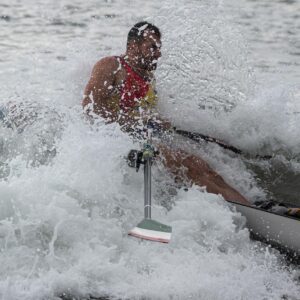In our Facebook group, we received the following comment a few years ago: “I am a 55-year-old man and started rowing at the age of 12 in school. I had my first DVT (deep vein thrombosis) at the age of 30.” Even though the statement was made some time ago, the topic of blood clots and rowers remains important. It’s time we looked at it again.
He is not an isolated case. Every year, 350,000 citizens in Germany, Switzerland, and Austria get a venous thrombosis. Suddenly, a blood clot forms and clogs a vein. This happens in most cases in the leg. Such a blockage not only hampers the circulation of the surrounding tissue and causes pain. If the fresh blood clot breaks lose, a life-threatening pulmonary embolism occurs at lightning speed.

Blood clots in rowers – The symptoms
„..I had the typical symptoms: a hot, aching, and swollen calf. First, a misdiagnosis was made. Since I was young and fit, it was believed that there was tension in the calf muscles. I took Coumadin for six months. The doctor was also not very worried, according to him, it was just a small thing. At that time, my right calf was always a bit thicker than the left and swelled properly in the evening. Once again I am told that I need not worry.
My wife is a health practitioner and specialized in lymphatic drainage. She explained to me that the swelling could come from a blood clot when it reaches a significant size.
In 2016, my usual workouts became increasingly difficult
I suddenly needed longer for the 500m on the rowing machine, and I had a difficulty picking up enough oxygen. When climbing stairs, I was increasingly struggling with shortness of breath. I returned to my GP, who already knew me and my medical history. Again, he assured me that everything was alright. After six months and further visits to the same doctor, he finally referred me to the cardiologist because he could not figure out my symptoms.
In January 2017, I had an appointment with a cardiologist and described to him my very nonspecific complaints. I did not have typical TVT symptoms as I had 25 years ago. The cardiologist declared my heart completely healthy. But since he knew of my medical history, he wanted to do another investigation to exclude a DVT. He considered a DVT very unlikely. The test was clearly positive. I was immediately taken to the hospital.
There they found out that I had an extensive DVT with 99% occlusion of the right femoral artery. In addition, a small DVT in the left calf and three pulmonary emboli were discovered. I was put on Warafin, which I now have to take for a lifetime. This was followed by several thorough examinations in various hematologists. I did not have blood anomalies or a genetic predisposition to thrombosis.”
Warning signs of possible blood clots: Thromboses arise in secret
Blood clots (thrombi) from red blood cells, platelets, and fibrin usually form below a venous valve because the blood easily accumulates here. There is an acute mortal danger if the thrombus breaks off, wanders and the lungs become clogged (pulmonary embolism). However, numerous other risk factors lead to the formation of dangerous blood clots. You can reduce most to a minimum without much effort. Rowers who are aware that thrombosis can occur should just make sure that the following risk factors exist.
The most important risk factors
- Venous diseases, eg. Renal insufficiency, varicose veins, inflammation, narrowing (also due to previous thrombosis)
- Diabetes mellitus
- Long duration of sitting down (in plane, bus, train, car or PC)
- Low fluid intake or fluid loss (diarrhea, dehydrating agent)
- Increased blood clotting and increased blood cell count
- Overweight
- Alcohol and nicotine abuse
I find the point with hydration even more interesting. I will from now on always have my water bottle on board.
Let’s look at a quote from the website Stop The Clot: „Doctors may take a long time to diagnose DVT – sometimes it does not happen at all. Blood clots, including deep vein thrombosis (DVT) and pulmonary embolism, are often not recognized as such, even if the athlete has typical symptoms. But why is that? It’s because doctors do not expect athletes to have problems with blood clots. Thrombosis is extremely rare in young, healthy people. Most athletes are young and healthy, which is why blood clots, DVTs, and pulmonary embolisms are not the norm.
Rowing and DVT
“To this day, my doctors do not know where my blood clots come from. However, I suspect that it has dehydration and elevated levels of lactate in the blood. Both can be triggered by hard training. As a masters rower, I train for about an hour on the rowing machine or in the boat every day. For both, I cover a distance of about 10 to 15 km. I live in South Florida, where the average temperature in summer is 90 ° F (32 ° C), and in winter it is 75-80 ° F (24-27 ° C). The humidity is very high. In one-hour rowing training, I lose sweating alone already two liters of liquid.”
Comments from other Rowers about the topic
We posted this post a couple of years ago and just want to show you a couple of comments we received.
Stanley wrote: Let’s control your homocysteine. An elevated level can cause thrombosis.
Peter Jago wrote: A really interesting article. Thank you for sharing. There are some useful tips on the internet to lower the lactate level during exercise. For example here: https://www.wikihow.com/Reduce-Lactic-Acid-Build-up-in-Muscles.
Understanding the symptoms and causes of lactate production is the first step in finding a solution to the problem. Adjusting the exercise routine and exercises is the next step. Even a change in diet, drinking enough and some soda dissolved in water, can help to prevent DVTs. And of course, continue your training.
This article highlights a big problem of Masters rowers. We all have to learn to classify our complaints because doctors are not always reliable. There are many information and support groups. As the population grows older and at the same time does more sport, it is essential to get important information and invest in research. Special for rowers who want to participate in Masters and continue to train. Arthritis is another important topic.
Mike Creamer wrote: This is especially interesting for me since I’m in my 50s and I’m a Masters rower myself. I, too, have had blood clots in recent years. I had my first thrombosis four years ago and the second one exactly a year later. Both blood clots were in the arteries of the lower legs, which is probably rather uncommon, since most of the blood clots are in veins. In the beginning a cause could not be found, because my heart was considered to be completely healthy and I have neither blood anomalies, nor a predisposition.
So far, I have never come up with the idea that it could have something to do with intensive training. Both blood clots happened in New York. Under high humidity, I trained very intensively on the rowing machine. Both clots were successfully removed. I also had to take warfarin, which I was able to resume and now take aspirin daily. In both cases, I resumed my training one to two weeks after surgery. Meanwhile, I can do my intensive training without any problems. Thanks for the link. I am looking forward to learning more about the relationship between lactate, dehydration, and blood clots.
By the way, my cardiologist has a suspicion how it could happen that my clots were in arteries instead of veins. He discovered a tiny hole (PFO) in my heart. It could have allowed the clots to pass from the venous to the arterial system. The hole has since been closed.
Noralee Griswold Minucci wrote: I am 76 years old and often row on the Tiber. My Easter vacation I spent in the intensive care unit because of a pulmonary embolism. And this for the third time. The first time right after birth, the second time after a skiing accident and the last time probably after rowing. It started with drawing pain in the calf. I also initially believed in simple muscle aches. However, it turned out to be a thrombosis from which the clot had come off.
Peter Bairstow wrote: I am a medical doctor and some contributions here are good. However, aspirin is not a recognized remedy for preventing venous thromboembolism. Although it has been shown to have a positive effect on arterial disease.
Although warfarin is the drug of choice for treating venous thrombosis and thromboembolism, it is associated with high risks. The dose should be adjusted again and again based on regular blood tests. New studies show that, even in the safe study situation, patients were only 50% therapeutic in their dose.
Of course, every drug has potential side effects and problems, but there are now many newer and better medicines. For them, the drug levels in the blood do not vary so much, and they are much safer. Seek here the conversation with your doctor.
If you have any further comments or want to contribute, please feel to comment on this article!







